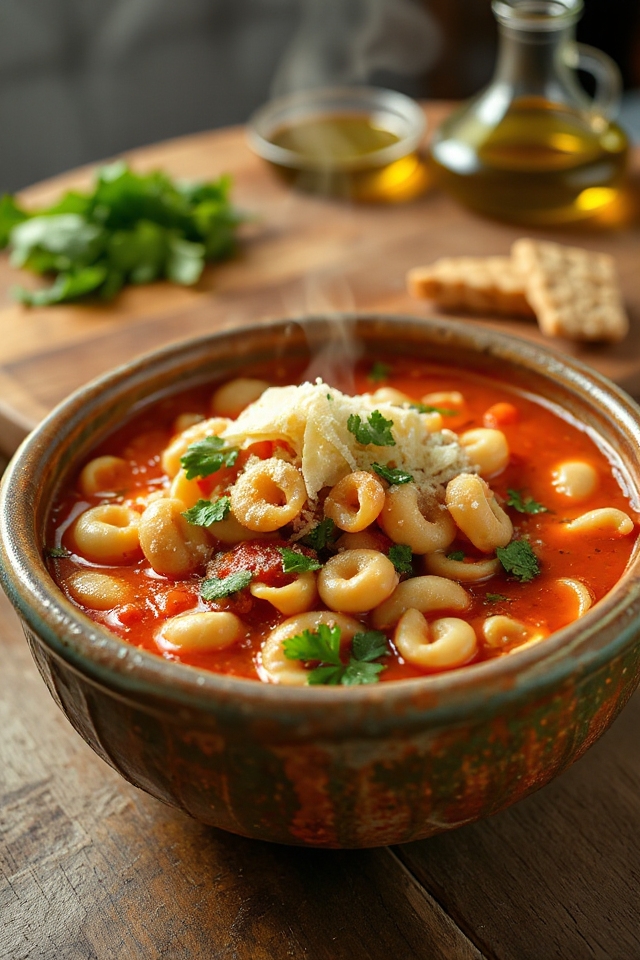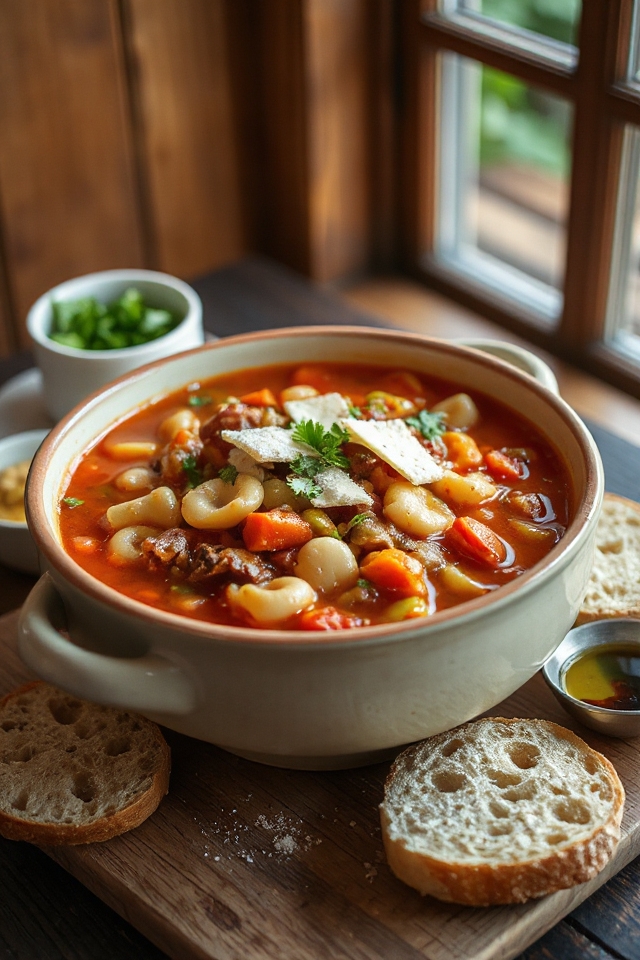Why You’ll Love This Italian Pasta Fagioli Recipe
When you plunge into this Italian Pasta Fagioli recipe, you’ll quickly understand why it’s a beloved classic.
The rich, hearty flavors blend perfectly, creating a comforting bowl that warms your soul. Each spoonful brings a delightful mix of textures, from tender pasta to creamy beans.
It’s not just a meal; it’s a celebration of Italian tradition. Plus, it’s incredibly versatile—great for a cozy family dinner or as a crowd-pleaser at gatherings.
The best part? It’s simple to make, allowing you to enjoy a homemade masterpiece without all the fuss.
Trust me, you’ll want to savor every bite!
Ingredients of Italian Pasta Fagioli
When it comes to making Italian Pasta Fagioli, the ingredients are just as important as the love you pour into the dish. This classic soup is all about those hearty, comforting flavors that come together beautifully. You might be thinking, “What do I need to whip up this deliciousness?” Don’t worry; I’ve got you covered. Below is a list of the essential ingredients that will help you create your own cozy bowl of Pasta Fagioli at home.
Ingredients for Italian Pasta Fagioli:
- 1 cup small pasta (like ditalini or elbow)
- 1 can (15 oz) cannellini beans, drained and rinsed
- 1 can (15 oz) diced tomatoes, with juices
- 1 medium onion, diced
- 2-3 cloves garlic, minced
- 2 carrots, diced
- 2 celery stalks, diced
- 4 cups vegetable broth (or chicken broth, if you prefer)
- 1 teaspoon dried oregano
- 1 teaspoon dried thyme
- Salt and pepper, to taste
- Olive oil, for sautéing
- Fresh parsley, chopped (for garnish)
- Grated Parmesan cheese (optional, but highly recommended!)
Now, let’s talk about some other considerations for these ingredients. You can totally play around with the types of beans you use—some folks swear by kidney beans or black beans for a twist.
And if you’re feeling adventurous, adding some greens like spinach or kale can give your soup a nice pop of color and nutrition.
Don’t have all the exact veggies? No problem. This recipe is pretty forgiving, so if you’re short on carrots or celery, just throw in what you have.
Cooking is all about making it your own, and trust me, your taste buds will thank you for it. Plus, who doesn’t love a recipe that’s as flexible as your yoga instructor?
How to Make Italian Pasta Fagioli

Alright, let’s immerse ourselves in the magical world of making Italian Pasta Fagioli. Envision this: a cozy kitchen, the aroma of sautéing vegetables wafting through the air, and a simmering pot filled with love.
It all starts with a splash of olive oil—just a couple of tablespoons should do it. Heat that up in a large pot over medium heat. Once it’s shimmering and ready, toss in 1 medium onion, diced, along with 2-3 cloves of minced garlic. Sauté these until the onion becomes soft and translucent, which usually takes about 5 minutes. This is where the magic begins; your kitchen will start to smell like a little piece of Italy.
Next, let’s get those veggies in there. Add in 2 diced carrots and 2 diced celery stalks, giving everything a good stir. You want these to soften up, so let them cook for about 5-7 minutes. While those are getting cozy, you can think about all the delicious flavors that are coming together.
After that, it’s time to bring in the big guns: pour in 4 cups of vegetable broth (or chicken broth if that’s more your style), and add 1 can of diced tomatoes with their juices and 1 can of drained and rinsed cannellini beans. Don’t forget to sprinkle in 1 teaspoon of dried oregano and 1 teaspoon of dried thyme, along with a sprinkle of salt and pepper. Stir it all together, and let it come to a gentle simmer.
Once everything is bubbling away, it’s time for the star of the show—1 cup of small pasta, like ditalini or elbow macaroni. Toss that in and let it cook according to the package instructions, usually around 8-10 minutes. Keep an eye on it, because nobody wants mushy pasta in their soup.
When it’s al dente, give your soup a final taste and adjust the seasoning if needed. Now, ladle that comforting goodness into bowls, sprinkle with fresh chopped parsley, and maybe add some grated Parmesan cheese on top if you’re feeling fancy.
And there you have it—you’ve just made a warm, hearty bowl of Italian Pasta Fagioli. It’s like a hug in a bowl, perfect for those chilly evenings or whenever you need a little pick-me-up. Enjoy every spoonful!
Italian Pasta Fagioli Substitutions & Variations
Whether you’re looking to accommodate dietary restrictions or simply want to mix things up, there are plenty of substitutions and variations for Italian Pasta Fagioli.
For a vegetarian twist, swap the pancetta for sautéed mushrooms or smoked paprika. If you need gluten-free options, use gluten-free pasta or beans, which also add protein. You can even experiment with different beans, like black or kidney beans, for a unique flavor.
For a creamier texture, stir in some spinach or kale. Don’t hesitate to adjust the spices based on your taste—add red pepper flakes for heat or fresh herbs for brightness!
What to Serve with Italian Pasta Fagioli
There’s nothing quite like a hearty bowl of Italian Pasta Fagioli, and the right sides can elevate this dish even further.
I love serving it with a simple arugula salad drizzled with lemon vinaigrette; the peppery greens offer a revitalizing contrast. A crusty loaf of Italian bread is perfect for soaking up the delicious broth.
Sometimes, I’ll add a side of roasted vegetables for a colorful touch. If you’re feeling indulgent, some grated Parmesan on top adds a lovely richness.
These sides complement the flavors beautifully and make for a comforting meal that’s sure to please everyone at the table.
Additional Tips & Notes
While preparing Italian Pasta Fagioli, don’t forget that the quality of your ingredients can make a significant difference in the final dish.
I always recommend using fresh herbs and good-quality canned beans for the best flavor. If you can, make your own broth; it’s worth the effort!
Don’t rush the cooking process, as letting the soup simmer allows the flavors to meld beautifully. If you like a thicker consistency, mash some of the beans or add more pasta.
And remember, this dish often tastes even better the next day, so don’t hesitate to make extra! Enjoy your cooking!
